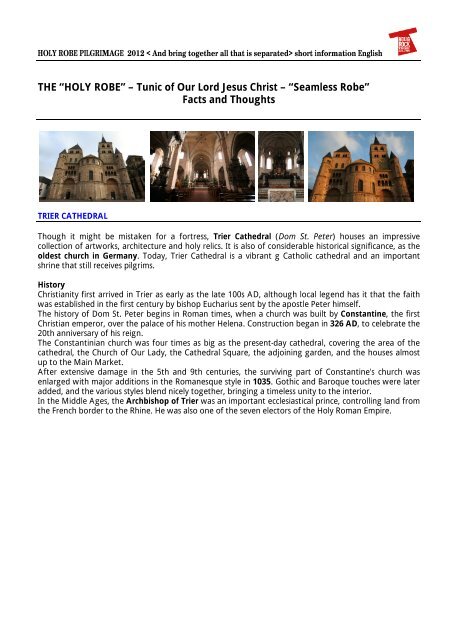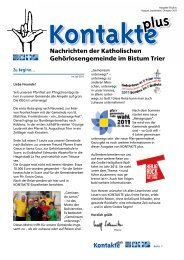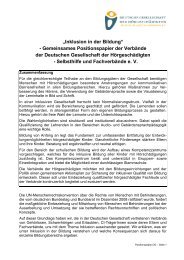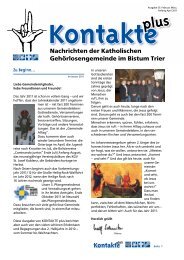THE “HOLY ROBE” – Tunic of Our Lord Jesus Christ – “Seamless ...
THE “HOLY ROBE” – Tunic of Our Lord Jesus Christ – “Seamless ...
THE “HOLY ROBE” – Tunic of Our Lord Jesus Christ – “Seamless ...
Create successful ePaper yourself
Turn your PDF publications into a flip-book with our unique Google optimized e-Paper software.
HOLY ROBE PILGRIMAGE 2012 < And bring together all that is separated> short information English<br />
<strong>THE</strong> <strong>“HOLY</strong> <strong>ROBE”</strong> <strong>–</strong> <strong>Tunic</strong> <strong>of</strong> <strong>Our</strong> <strong>Lord</strong> <strong>Jesus</strong> <strong>Christ</strong> <strong>–</strong> <strong>“Seamless</strong> Robe”<br />
Facts and Thoughts<br />
TRIER CA<strong>THE</strong>DRAL<br />
Though it might be mistaken for a fortress, Trier Cathedral (Dom St. Peter) houses an impressive<br />
collection <strong>of</strong> artworks, architecture and holy relics. It is also <strong>of</strong> considerable historical significance, as the<br />
oldest church in Germany. Today, Trier Cathedral is a vibrant g Catholic cathedral and an important<br />
shrine that still receives pilgrims.<br />
History<br />
<strong>Christ</strong>ianity first arrived in Trier as early as the late 100s AD, although local legend has it that the faith<br />
was established in the first century by bishop Eucharius sent by the apostle Peter himself.<br />
The history <strong>of</strong> Dom St. Peter begins in Roman times, when a church was built by Constantine, the first<br />
<strong>Christ</strong>ian emperor, over the palace <strong>of</strong> his mother Helena. Construction began in 326 AD, to celebrate the<br />
20th anniversary <strong>of</strong> his reign.<br />
The Constantinian church was four times as big as the present-day cathedral, covering the area <strong>of</strong> the<br />
cathedral, the Church <strong>of</strong> <strong>Our</strong> Lady, the Cathedral Square, the adjoining garden, and the houses almost<br />
up to the Main Market.<br />
After extensive damage in the 5th and 9th centuries, the surviving part <strong>of</strong> Constantine's church was<br />
enlarged with major additions in the Romanesque style in 1035. Gothic and Baroque touches were later<br />
added, and the various styles blend nicely together, bringing a timeless unity to the interior.<br />
In the Middle Ages, the Archbishop <strong>of</strong> Trier was an important ecclesiastical prince, controlling land from<br />
the French border to the Rhine. He was also one <strong>of</strong> the seven electors <strong>of</strong> the Holy Roman Empire.
HOLY ROBE PILGRIMAGE 2012 < And bring together all that is separated> short information English<br />
<strong>THE</strong> HOLY ROBE<br />
SCRIPTURE: John 19,23-24<br />
“When the soldiers had crucified <strong>Jesus</strong>,<br />
they took his clothes and divided them into four parts,<br />
one for each soldier.<br />
They also took his tunic;<br />
now the tunic was seamless,<br />
woven in one piece from the top.<br />
So they said to one another,<br />
“Let us not tear it,<br />
but cast lots for it to see who will get it.”<br />
This was to fulfill what the scripture says,<br />
“They divided my clothes among themselves,<br />
and for my clothing they cast lots.”<br />
According to the Gospel <strong>of</strong> John, the soldiers who crucified <strong>Jesus</strong> did not divide his tunic after crucifying<br />
him, but cast lots to determine who would keep it because it was woven in one piece, without seam. A<br />
distinction is made in the New Testament Greek between the himatia (literally “over-garments”) and the<br />
seamless robe, which is chiton, (literally “tunic” or “coat”).<br />
“Then the soldiers, when they had crucified <strong>Jesus</strong>, took His garments (ta himatia) and divided them into<br />
four parts, to every soldier a part, and the coat (kai ton chitona). Now the coat was without seam,<br />
woven whole from the top down. Therefore, they said among themselves, let us not tear it, but cast lots<br />
for it, whose it will become. Thus the saying in Scripture was fulfilled: they divided My raiment (ta imatia)<br />
among them, and upon My vesture (epi ton himatismon) did they cast lots” (John 19:23-24; quoting the<br />
Septuagint version <strong>of</strong> Psalm 21 [22]:18-19).<br />
The naked king<br />
the four soldiers who crucify <strong>Jesus</strong><br />
strip him <strong>of</strong> his clothes.<br />
He becomes the naked King.,<br />
stripped <strong>of</strong> power, mobility and dignity,<br />
to reveal the truth <strong>of</strong> love in and <strong>of</strong>fering <strong>of</strong> self.<br />
Truth can be so stark that we turn our eyes away from it.<br />
They decide to cut his outer garment into four pieces,<br />
one for each <strong>of</strong> them,<br />
but the tunic is seamless, woven in one piece,<br />
probably by the mother <strong>of</strong> <strong>Jesus</strong>.<br />
The soldiers do not tear it but cast lots to see who would get it.<br />
The gospel notes with a certain solemnity that they did tihs<br />
in order to fulfill Scripture:<br />
They divided my garments among them<br />
and cast lots for my clothing. Ps 22:18<br />
Jean Vanier,<br />
Drawn into the Mystery <strong>of</strong> <strong>Jesus</strong><br />
through the Gospel <strong>of</strong> John, p. 322
HOLY ROBE PILGRIMAGE 2012 < And bring together all that is separated> short information English<br />
HISTORY<br />
The Empress St. Helena is known for her pilgrimages to the Holy Land, and pious legend has it that she<br />
brought back the Holy Robe <strong>of</strong> <strong>Christ</strong> from Jerusalem and entrusted it to her son's new church at Trier.<br />
The Holy Robe is the seamless garment said to be worn by <strong>Christ</strong> during the Crucifixion.<br />
According to one tradition, Helena, mother <strong>of</strong> Constantine the Great discovered the seamless robe in the<br />
Holy Land in the year 327 or 328 along with several other relics, including the True Cross. According to<br />
different versions <strong>of</strong> the story, she either bequeathed it or sent it to the city <strong>of</strong> Trier, where Constantine<br />
had lived for some years before becoming emperor. (The monk Altmann <strong>of</strong> Hautvillers wrote in the 9th<br />
century that Helena was born in that city, though this report is strongly disputed by most modern<br />
historians.)<br />
The Robe first makes an appearance in written documents in the 12th century. In 1512, the high altar <strong>of</strong><br />
Trier Cathedral was opened and the Robe was found inside, along with other important relics from the<br />
Holy Land.<br />
The Holy Robe was first displayed in Trier in 1512 for a period <strong>of</strong> 23 days, during which more than<br />
100,000 pilgrims came to venerate it.<br />
The next year, a wooden balcony was built onto the west front <strong>of</strong> the cathedral in order to display the<br />
Holy Robe and the other Trier relics to crowds gathered in Cathedral Square. It has been periodically<br />
displayed since then, attracting ever-larger crowds.<br />
The expositions in public were rare:<br />
1513, 1514, 1515, 1516, 1517, 1524, 1538, 1545, 1655, 1810, 1844, 1891,<br />
In the last century: 1933, 1959, 1996<br />
The exposition <strong>of</strong> the relic, for three weeks in 1933, drew 2 million pilgrims. In 1959, the relic was sealed<br />
in a splendid shrine in its own chapel, where it remains today. Since the Cathedral renovation in 1974,<br />
the Holy Robe has been kept in its wooden shrine from 1891, lying under an air-conditioned glass shrine.<br />
The Holy Robe was exposed again in 1996, 800 years after it was immured in the main altar. The last<br />
great pilgrimage, in 1996, became a joyful celebration <strong>of</strong> about 700 000 pilgrims from all over the world.<br />
In 2012 the Holy Robe will be displayed again <strong>–</strong> to remember its first public display in 1512.<br />
The relic is enshrined in a reliquary housed in the specially-built baroque Chapel <strong>of</strong> the Holy Robe,<br />
located behind the altar. You can just get a glimpse <strong>of</strong> the large shrine, and much <strong>of</strong> the splendid Chapel<br />
remains hidden as well.<br />
Only during the Holy Robe Days the Holy Robe chapel is accessible, but the garment cannot be viewed.<br />
The original state <strong>of</strong> the textile has altered because <strong>of</strong> past events and the unfavorable storage<br />
conditions, as repairs have frequently been made.<br />
HISTORY and FAITH<br />
The question <strong>of</strong> the authenticity <strong>of</strong> the Holy Robe cannot not be answered with certainty. For the<br />
faithful, the symbolism is important: the relic signifies <strong>Jesus</strong> <strong>Christ</strong> himself<br />
• his incarnation<br />
• his humanity<br />
• his solidarity with the poor
HOLY ROBE PILGRIMAGE 2012 < And bring together all that is separated> short information English<br />
• his crucifixion and his death<br />
• his presence after his resurrection<br />
• his call to unity among his people<br />
SYMBOL for CHRISTIAN UNITY<br />
The undivided and seamless garment is a symbol <strong>of</strong> undivided <strong>Christ</strong>ianity, since the early Fathers <strong>of</strong><br />
Faith (cf. Augustine, Tractatus in Joannis Evangelium 118; Cyprian <strong>of</strong> Carthago, De unitate ecclesiae<br />
Cap7).<br />
Despite its symbolism since the 16 th century the veneration <strong>of</strong> the Holy Robe has been a sign <strong>of</strong> the<br />
separation among the <strong>Christ</strong>ian churches and denominations. Features <strong>of</strong> the Catholic rituals and<br />
teachings prompted Protestants to protest. Martin Luther called it rudely the “Scam <strong>of</strong> Trier”.<br />
In 1996 the Holy Robe became a strong sign for the Ecumenical desire for <strong>Christ</strong>ian unity. Bishop Dr.<br />
Hermann Josef Spital invited all <strong>Christ</strong>ian traditions to accompany and participate in the pilgrimage. The<br />
president <strong>of</strong> the Protestant Church in the Rhineland wrote one <strong>of</strong> the most prominent pilgrim hymns.<br />
In the preparation for the pilgrimage in 2012 a leading person in the Protestant Church <strong>of</strong> the Rhineland<br />
has recently suggested a new different approach: “Protestants trust the “Text” more than a “textile” <strong>–</strong><br />
but when a “textile” leads to the “Text”, there is nothing wrong about that.” The Protestant<br />
superintendant <strong>of</strong> Trier said: “We trust the Catholics in the Diocese <strong>of</strong> Trier, as we have a long and<br />
steadfast experience <strong>of</strong> cooperation. We will remain Protestants <strong>–</strong> and yet participate as much as we<br />
can.”<br />
PILGRIM PRAYER<br />
The Trier pilgrim prayer expresses <strong>Christ</strong>’s call and our desire for <strong>Christ</strong>ian unity:<br />
"<strong>Jesus</strong> <strong>Christ</strong>, Savior and Redeemer,<br />
have mercy on us and all the world.<br />
Remember your <strong>Christ</strong>ian people,<br />
and bring together all that is separated.<br />
Amen.”
HOLY ROBE PILGRIMAGE 2012 < And bring together all that is separated> short information English<br />
PILGRIMAGE 2012<br />
Motto: “… and bring together all that is separated!”<br />
636 ideas about a motto arrived in the Pilgrim’s Office when Bishop Ackermann invited the diocese to<br />
come up with suggestions…<br />
On April 25, 2010 the “winner” was published: “… and bring together all that is separated”<br />
A simple line: The last line <strong>of</strong> the Holy Robe Pilgrim prayer.<br />
The motto for the Pilgrimage 2012: “<br />
… and bring together all that is separated”<br />
It summons our fundamental desire for life and faith:<br />
Calling for God’s shepherding in the many areas <strong>of</strong> our existence.<br />
The Holy Robe is one <strong>–</strong> seamless: a symbol for unity <strong>–</strong> beyond separation.<br />
A redeemed world.<br />
… and bring together all that is separated”<br />
Separation, division, alienation define our lives: on the personal level, in relationships, our families and<br />
communities, in our society, in our church. Separation, alienation hurt and cause pain.<br />
We look out for healing, reconciliation, redemption.<br />
… and bring together all that is separated”<br />
Separation, division, alienation are part <strong>of</strong> our human condition, they were there before we were born,<br />
but they are also consequences <strong>of</strong> our actions and words and omissions. We are not only victims but<br />
committers.<br />
… and bring together all that is separated”<br />
<strong>Jesus</strong> left his disciples with his testament and his vision <strong>of</strong> salvation:<br />
I ask not only on behalf <strong>of</strong> these,<br />
but also on behalf <strong>of</strong> those who will believe in me through their word,<br />
that they may all be one.<br />
As you, Father, are in me and I am in you,may they also be in us,<br />
so that the world may believe that you have sent me.<br />
Jn 17,20<br />
Unity and salvation are the two sides <strong>of</strong> the same coin.<br />
When the world finds together, salvation is growing.<br />
Salvation calls for unity.<br />
… and bring together all that is separated”<br />
Unity is creative, brings something new. Something which maybe never existed before.<br />
Is more then just collecting separate pieces. Unity is a miracle. A gift. Has a new quality.<br />
A flock is more then just the sum <strong>of</strong> each and every sheep. A flock is “catholic”: unifying, united.<br />
Unity has many faces, experiences, languages, colors. Unity is a fabric with many threads.
HOLY ROBE PILGRIMAGE 2012 < And bring together all that is separated> short hort information English<br />
“… and bring together what is separated”<br />
To prepare ourselves in the year before the pilgrimage Catholic Charities in the Trier diocese invite their<br />
lay groups and their agencies to look deeper into some areas <strong>of</strong> separations we are facing in our “charity<br />
work”:<br />
1) Circumstances <strong>of</strong> life: poor and rich<br />
2) Inclusion: live together with and with/without handicaps<br />
3) Generations: youngsters and seniors<br />
4) Commitment: volunteers and pr<strong>of</strong>essionals<br />
5) Life at the borderlines: sick and health healthy<br />
6) Relationships with distance: counselor and client<br />
7) One ministry: charity and pastoral care<br />
8) Being in relationships: Communication and presence<br />
9) We and the others: belonging, migration, ecumenical relations<br />
People are invited to prepare themselv themselves es together throughout the year 2011/2012 and then come<br />
together to the Holy Robe between April, 13 and May 13 2012.












